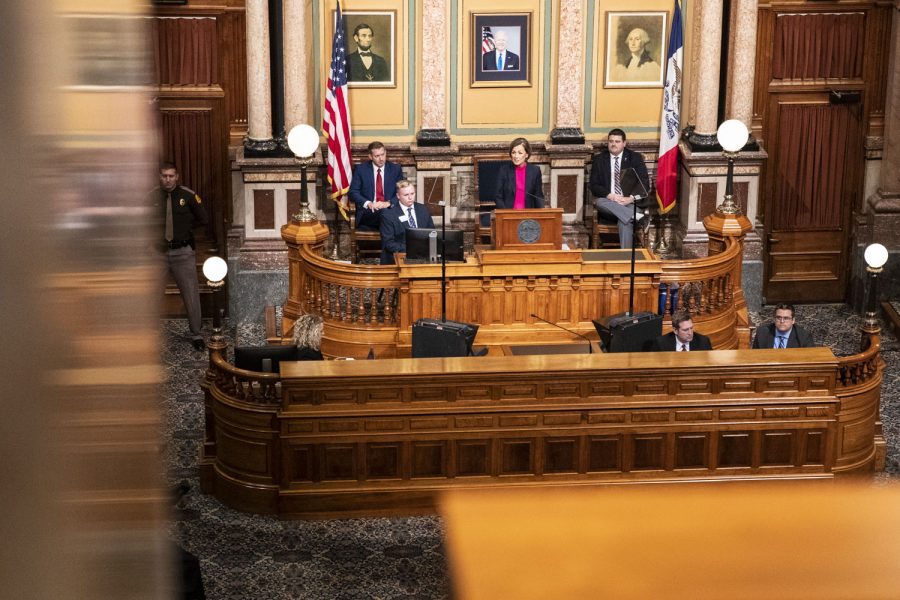Opinion | School choice should not override public school funding
Allotting public funding to private schools does not help serve most students
Iowa Governor Kim Reynolds delivers the Condition of the State address at the Iowa State Capitol in Des Moines, Iowa, on Tuesday, Jan. 11, 2022. During the State address, Reynolds spoke about childcare, Iowa teachers, material taught in schools, unemployment, tax cuts, and more. Reynolds announced the expansion of the Childcare Challenge Program with over 5,000 more childcare openings across the state.
March 22, 2022
Iowa Gov. Kim Reynolds has proposed public dollars go to private school scholarships. The bill’s goal is to remove financial barriers for families who might want to choose private or homeschooling options. Although the intention is provide more equitable access, taking away funds from the most accessible form of education isn’t what’s best for students in need.
This bill isn’t exactly a new initiative. During her 2021 Condition of the State speech, Reynolds proposed creating a program that uses public dollars to subsidize private school tuition.
There has been opposition to this bill across all party lines. According to a Des Moines Register poll, 57 percent of Iowa Republicans are in favor of the bill, which has increased since last year. Republicans have expressed support for this bill because it allows for more school choice where parents can choose schools that might align with their personal beliefs.
In contrast, 73 percent of Iowa Democrats oppose the bill, a percentage that has also increased since last year. Democrats have noted how most students attend public schools, which is why money should go to supporting the majority.
All in all, 52 percent of Iowans do not support the bill.
Although it is slight, most of the state opposes putting public funding in private schooling. Instead of allocating funds that would typically go to public schools to private school scholarships, Reynolds should be looking at ways to better support the schools that serve the majority of Iowans.
The total recorded number of students enrolled in non-public schools for 2021-2022 is 33,597 students. The number of students attending public school in Iowa has slightly increased since the pandemic, with enrollment at 485,630.
To put this into further perspective, private school enrollment makes up for around 6.5 percent of total enrollment. With this being such a small population, we should be turning our focus to public education, which serves over 93 percent of the state.
Public education in Iowa has taken a hit since the pandemic, which is even more reason to keep public dollars in public schools.
Iowa’s education system was ranked 23rd in the country by the World Population Review. The ranking was based on safety as well as quality of education, which included metrics like college readiness and graduation rates. Over the past several years, we have seen drops in some of these metrics, especially for minority students.
The African American graduation rate dropped 4 percent since 2018. Alarmingly, Asian and Pacific Islander graduation rates dropped almost 10 percent since 2018. Clearly, students and public schools need more support instead of less right now.
Instead of allocating more funds to private schools and only increasing supplementary state aid by 2.5 percent, Iowa needs to allot funding appropriate for the costs public schools are facing. Democrats proposed a 5 percent funding increase which would amount to 300 million dollars from the state. Instead of investing this money in education, Iowa Republicans opposed this increase and gave corporations 300-million-dollar tax cuts.
Public education is a necessary and vital resource for the majority of Iowa’s children and families. Repeatedly, we have seen the government support public schooling less and less through funding and various types of censorship. If Iowa plans on furthering education, there needs to be a push to invest more money and resources.
Columns reflect the opinions of the authors and are not necessarily those of the Editorial Board, The Daily Iowan, or other organizations in which the author may be involved.



